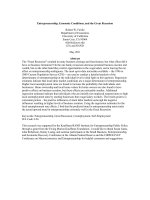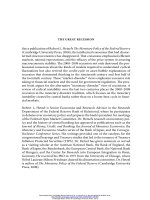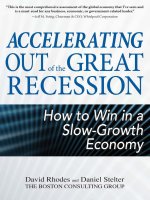rosenberg - the concise encyclopedia of the great recession, 2007-2000 (2010)
Bạn đang xem bản rút gọn của tài liệu. Xem và tải ngay bản đầy đủ của tài liệu tại đây (1.13 MB, 406 trang )
THE CONCISE
ENCYCLOPEDIA OF
THE GREAT RECESSION
2007–2010
Jerry M. Rosenberg
The Scarecrow Press, Inc.
Lanham • Toronto • Plymouth, UK
2010
Published by Scarecrow Press, Inc.
A wholly owned subsidiary of The Rowman & Littlefield Publishing Group, Inc.
4501 Forbes Boulevard, Suite 200, Lanham, Maryland 20706
Estover Road, Plymouth PL6 7PY, United Kingdom
Copyright © 2010 by Jerry M. Rosenberg
All rights reserved. No part of this book may be reproduced in any form or by any
electronic or mechanical means, including information storage and retrieval systems,
without written permission from the publisher, except by a reviewer who may quote
passages in a review.
British Library Cataloguing in Publication Information Available
Library of Congress Cataloging-in-Publication Data
Rosenberg, Jerry Martin.
The concise encyclopedia of the great recession 2007–2010 / Jerry M. Rosenberg.
p. cm.
Includes bibliographical references and index.
ISBN 978-0-8108-7660-6 (hardback : alk. paper) — ISBN 978-0-8108-7661-3 (pbk. :
alk. paper) — ISBN 978-0-8108-7691-0 (ebook)
1. Financial crises—United States—History—21st century—Dictionaries. 2.
Recessions—United States—History—21st century—Dictionaries. 3. Financial
institutions—United States—History—21st century—Dictionaries. I. Title.
HB3743.R67 2010
330.9'051103—dc22 2010004133
ϱ
™
The paper used in this publication meets the minimum requirements of
American National Standard for Information Sciences—Permanence of Paper
for Printed Library Materials, ANSI/NISO Z39.48-1992.
Printed in the United States of America
For Ellen
Celebrating fifty years of love and adventure.
She is my primary motivation.
As a lifelong partner, Ellen
keeps me spirited and vibrant.
Listen less to those whose judgments brought us this crisis. Listen less to
those who told us all they were the masters of noble financial innovation
and sophisticated risk management. Listen less to those who complain
about the burdens of living with smarter regulation or who oppose having
to pay a few for the costs of this or future crises. . . . Risk will build up
again . . . and future governments will have to act again to socialize private
losses in the interest of preventing catastrophic damage.—U.S. Treasury
Secretary Timothy Geithner, March 22, 2010
v
CONTENTS
Preface vii
Acknowledgments xi
Reader’s Note xiii
Dictionary 1
Index 371
About the Author 391
vii
PREFACE
It seemed to be a calm and typical summer. In mid-2008, the American econ-
omy was in a strong position as its gross domestic product grew by an annu-
alized 3.3 percent, in part reflecting a strong trade performance. U.S. wealth
had reached $14 trillion annually. Despite rising unemployment, soaring fuel
prices, and constricting credit, consumer spending managed to grow at a 1.7
percent annual rate. President George W. Bush introduced a fiscal stimulus
package that included $110 billion in tax rebates, of which $92 billion had
been disbursed by early July. Then, the second half of the year began to look
weaker. Real consumer spending tumbled at a 0.4 percent monthly rate.
By the end of 2008, the S&P 500 had declined 38 percent, jobs lost came
to 1.9 million, and the U.S. government owned stock in 206 banks. The $700
billion bank bailout plan—the Troubled Asset Relief Program (TARP)—was
passed by Congress on October 3, 2008, yet failed to fulfill the needs of the
nation. And 2009 looked worse. Moving quickly, once he was inaugurated in
January, President Barack Obama succeeded in getting a complex, expensive,
and lengthy economic stimulus package passed by Congress in February, fol-
lowed by the new Treasury secretary’s plans for ways to effectively use the
unspent $350 billion of TARP funds. The next day, the Dow Jones Industrial
Average plummeted nearly 5 percent in response to what was considered to
be the administration’s lack of clarity; specifics were missing.
As the rescue tab rose, taxpayers were not being “adequately informed or
protected.” These gambles are the reason the government should have at-
tached more strings to its help, including a say in how the money was used.
To finance the bailouts, the U.S. Treasury was borrowing money and the
Federal Reserve Bank was printing it. That bodes ill for a heavily indebted
nation, presaging higher interest rates and higher prices—perhaps sharply
higher. By mid-February, the president had signed into law the American
Recovery and Reinvestment Act, followed by a housing plan to help nearly
10 million homeowners avoid foreclosure, with promises of more funds to
come as needed.
By the summer 2009, there were more than five unemployed American
workers for every job opening. The ranks of the poor continued to escalate,
welfare rolls were rising, and those under thirty years of age had sustained
viii • PREFACE
nearly half the job losses since November 2007. A month before the melt-
down began there were about 7 million Americans counted as unemployed;
today there are about 15 million. By the end of 2009, there were six times as
many Americans seeking work as there were job openings, and the average
duration of unemployment—the time the average job seeker spends looking
for work—was more than six months, the highest level since the 1930s. As
promised by the government, new regulators and complicated federal regula-
tions are appearing, all purporting to stop the leakage and misuse of the public
trust. On Wall Street, 2010 will likely be known as the year of the regulator,
with the most significant overhaul in seventy-five years.
This recession has touched Americans across incomes and races. It has
slashed family earnings, increased poverty, created increased anxieties and
emotional depression, and left more people without health insurance. Median
household income fell 3.6 percent to just over $50,000, the steepest year-
over-year fall in forty years. The poverty rate, at 13.2 percent, was the highest
since 1997. And about 700,000 more people didn’t have health insurance in
2008 than twelve months prior.
One year following the collapse of Lehman Brothers on September 15,
2008, few of the numerous government proposals to reshape the banking and
financial industries were in place. Today, most of the institutions that received
government funds are doing well. In mid-September 2009, the chairman of
the Federal Reserve declared that it appeared that the recession had come to
an end and that the economy was turning upward, while at the same time,
housing foreclosures and unemployment continued to climb. The jobless rate
then hit 10.2 percent in October, the highest since 1982; more than one out of
every six workers—17.5 percent—were unemployed or underemployed. Of-
ficially, the Great Recession began in December 2007; unofficially it ended
in the early fall 2009. However, for the 15 million unemployed and for those
experiencing the meltdown, the year 2010 was part of their nightmare.
GOALS
Global understanding is a major part of the new world economic order. This
volume attempts to spell out the activities and events of the past two years
and to be a guide to help navigate the reader through this economic downturn.
With current, accurate, and sufficiently detailed explanations of the economic
seesaw of 2008–2009 and into 2010, this book should help readers to better
understand the reasoning, motives, hidden agendas, and power plays of those
who are responsible for this debacle and, most important, what the govern-
ment has done to try to overcome it. At the same time, this historical and fac-
PREFACE • ix
tual encyclopedia, based on daily reports from the media and from specialists
in the field, will provide readers with the necessary resources for planning
future moves for themselves and their families, friends, and colleagues.
To the user of this volume, it is my hope that this volume will prove to be
a rewarding learning experience. I look forward to receiving your comments
and suggestions that may assist me in the continuous upgrading of this book.
Email:
xi
ACKNOWLEDGMENTS
No work of this nature can be the exclusive product of one person’s effort.
Even when written by one individual, such a work requires the tapping of
many sources, which is especially true of this book. By the very nature of
the subjects and fields included, I have had to rely on the able and extensive
efforts of others, especially writers, practitioners, and specialists. I have not
deliberately quoted from any copyrighted source. Any apparent similarity to
existing, unreleased explanations in these cases is purely accidental and the
result of the limitations of language. Various organizations have aided me
directly by providing informative sources. Some government agencies and
nonprofit associations have provided a considerable amount of usable infor-
mation. In addition, being, according to the New York Times, “the leading
business and technical lexicographer in the nation” has allowed me to borrow
entries from my eight business dictionaries.
During the preparation of this book, beginning in fall 2007 until the end
of 2009, numerous reliable sources have been tapped. The Wall Street Jour-
nal, the International Herald Tribune, and the New York Times have been
particularly useful tools. To a lesser extent the Economist and the Financial
Times of London were helpful in presenting a needed global perspective. In
addition, most of the country introduction write-ups are drawn extensively
from information provided by the Organization for Economic Cooperation
and Development (OECD). I acknowledge these print sources for this data in
each country’s entry. I could not have achieved my goals without their profes-
sional wisdom and input.
On a personal level, I thank the many professionals and specialists whom I
used as a sounding board to clarify my ideas and approach; they offered valu-
able suggestions and insight and encouraged me to move ahead. A special
thanks to Gregory Henderson, a former MBA student, who is currently vice
president in a major finance company in New York City. He has devoted an
enormous amount of hours and talent to reviewing my listings and correcting
errors, thereby validating many of the entries. To my publisher, Ed Kurdyla,
senior editor Stephen Ryan, and production editor Jessica McCleary at Scare-
crow Press, I add my appreciation for their willingness and encouragement to
proceed with this project.
xii • ACKNOWLEDGMENTS
Then, there are those who have been closest to me. Nothing has been more
fulfilling than sharing an adult lifetime, first with my wife, Ellen, who for
fifty years has contributed immensely to my limited talents by providing her
gifts of charm, responsibility, orientation to family, and intellect, and as a
partner sharing adventure. Lauren and Bob, Liz and Jon are the next genera-
tion, and they appear already in place as contributors to their communities
and chosen areas of work. Of course, four grandchildren—Bess, Ella, Celia,
and Rita—make this all come full circle, with the delights of just watching
and being fascinated by the ever-changing rainbow in their lives.
xiii
READER’S NOTE
The Concise Encyclopedia of the Great Recession 2007–2010 has been pre-
pared with the hope that the reader’s understanding of the entries will help
in the sharing of information and ideas. Hopefully, the confusion about the
events that have occurred during this difficult time will be reduced, and this
record will serve as a consistent, accurate, and informative resource. Most
importantly, it should help people gain clarity about the significant economic
issues of the past several years. Entries can take on different meanings in
different contexts and situations, and a goal of this encyclopedia is to be
inclusive and to present all the key elements for each entry. I have organized
this work to provide these elements easily and rapidly.
DATES
Some entries provide dates that are essential to understanding the sequence of
events. At the first appearance, a date is given by month, day, and year; the
year may not be repeated when placed alongside different months and days
within the same year. It should be assumed that the year remains constant
until the next year appears. For example, January 8, 2008, is given, followed
by February 5, March 14, and so on, all in 2008. When the next full date is
given, for example, January 12, 2009, that triggers a new year for the subse-
quent months and days.
ALPHABETIZATION
Entries are presented alphabetically. The listings are alphabetized up to the
first comma and then by words following the comma, thus establishing clus-
ters of related terms. Entries with numerals are listed according to the spelling
of the number.
xiv • READER’S NOTE
ENTRIES
The current most common entry is usually given as the principal one, with
others cross-referenced to it. Some terms have been included for historical
significance only; some entries are given as background to enhance the user’s
understanding of the recent meltdown events; others are included to assure
the smoothness of transition from the past one hundred years of political and
economic institutions, regulations, and rules.
CROSS-REFERENCES
“See” and “See also” references are suggested to provide the reader with
additional, often related, and significant information. Utilizing these listings
will provide a deeper and expanded sense of the entry. The use of “Cf.” sug-
gests entries to be compared with the original one. “Synonymous with” fol-
lowing a description does not imply that the entry is exactly equivalent to the
principal title under which it appears. Usually the entry only approximates the
primary sense of the original term.
FEEDBACK
Major entries have been reviewed by bank/finance/legal specialists and
educators. However, I am solely responsible for including the entries and
descriptions. I welcome suggestions and critical comments bringing errors to
my attention.
1
A
ABA. See AMERICAN BANKERS ASSOCIATION.
ABC. The television division of the Walt Disney Company announced on
January 29, 2009, that it would eliminate about 400 jobs from its work force
of 6,500 to 7,000 because of the weakening economy.
First-quarter profit dropped 46 percent. Ongoing promotion helped in-
crease its hotel occupancy to 89 percent, up slightly from the previous year
in their Florida resort. Its theme division shed about 1,900 jobs through a
combination of layoffs and buyouts and restructured many of its behind-the-
scenes operations.
Profit declined in the second quarter 2009 by 26 percent. Net income fell
to $954 million from $1.28 billion the year earlier.
Fourth-quarter 2009 profit at Walt Disney rose 18 percent, with an $895
million profit. ABC profit climbed 26 percent on a 14 percent revenue gain.
ABERCROMBIE & FITCH CO. Reported a 68 percent drop in its fiscal
fourth-quarter earnings of 2008. The firm expected deep losses into 2009.
Abercrombie lowered prices as much as 90 percent over the Christmas 2008
buying season.
After reporting a larger-than-expected fiscal first-quarter 2009 loss in May
the firm had a 24 percent decline in revenue for the quarter ending May 2,
while sales at stores open for more than a year fell a sharper 30 percent.
Abercrombie & Fitch posted a quarterly loss of $26.7 million on August
14, 2000. Sales fell 23 percent to $648.5 million; revenue decreased 15 per-
cent to $765.4 million.
ABU DHABI. See BARCLAYS; DAIMLER; DUBAI; UNITED ARAB
EMIRATES.
AB VOLVO. See FORD; VOLVO.
ACCOR. The global hotel company announced on July 16, 2009, that its
second-quarter sales fell 9 percent.
Cf. MARRIOTT.
ACCOUNTABILITY. The quality or state of being accountable; an obliga-
tion or willingness to accept responsibility or to account for one’s actions.
Becoming more important since the Great Recession took hold.
See also EMERGENCY ECONOMIC STABILIZATION ACT OF
2008; FINANCIAL STABILITY OVERSIGHT BOARD; REGULATION;
TRANSPARENCY.
ACCOUNTANTS. Accountants have been accused of failing to protect the
public interest before, during, and following the Great Recession. Questions
remain—why didn’t they know that the major banks were hiding assets off their
balance sheets and stretching regulations, if not outright breaking them?
ACCOUNTING RULES. See FINANCIAL CRISIS ADVISORY GROUP.
ACQUISITIONS. See MERGERS AND ACQUISITIONS.
ADB. See ASIAN DEVELOPMENT BANK.
ADIDAS. Reported a 93 percent fall in second-quarter 2009 net profit.
Adidas’s total quarterly sales fell 2.5 percent.
See also RETAILING.
ADMINISTRATION. In the United Kingdom, a term synonymous with
bankruptcy protection.
ADVANCED MICRO DEVICES INC. Reported in January 2009, a $1.42
billion fourth-quarter loss, resulting from a rapidly deteriorating environment
for computer sales as well as big write-offs.
ADVERSE FEEDBACK LOOP. The combination of job losses and falling
corporate profits that creates new loan defaults, which hurt banks beyond the
original mortgage problems that began the 2008–2009 economic collapse.
ADVERTISING. Worldwide, in 2009, spending for advertising slipped
0.2 percent to $490.5 billion, led by a 6.2 percent drop in the United States,
the first decline since 2001. Advertising spending in the United States fell 2
percent in the third quarter 2008 as the recession prompted cutbacks, with
the steepest toll on national spot radio spending, which dropped 18 percent
from 2007. Most forecasts for 2009 predicted general advertising to fall by 5
percent or more, and 9 percent specifically on television. The fate of the car
industry is critical, as it spends around $20 billion a year on advertising. Car
ads contribute up to 25 percent of advertising revenues for local television
channels. Assuredly, advertising agencies will suffer.
U.S. advertising spending on media such as TV, print, and online display
ads dropped 14 percent to $30.18 billion in the first quarter 2009 from a year
earlier. The top ten advertisers for the first quarter 2009, by ad spending, in
millions were:
2 • ACCOUNTABILITY
a. Procter & Gamble—$674.1
b. Verizon Communications—$577.1
c. AT&T—$459.4
d. General Motors—$424.2
e. Johnson & Johnson—$397.2
f. News Corporation—$341.2
g. Sprint Nextel—$317.7
h. Walt Disney—$303.7
i. Time Warner—$263.4
j. General Electric—$261.4
See also INTERNET ADVERTISING; LUXURY GOODS; RETAILING.
AER LINGUS. In November 2009, the airline reported that revenue for
the three months ending September 30 fell 9.7 percent from the year before,
slowing from a 12 percent year-to-year decline in the first half.
See also AIRLINES.
AFGHANISTAN. See WARS IN AFGHANISTAN AND IRAQ.
AFRICA. At first minimally affected by 2008 meltdown, South Africa, the
region’s largest economy, closely linked to the outside world, was the first to
feel the impact of the global meltdown.
By November 1, 2008, its currency, the rand, lost about 30 percent of its
value against the U.S. dollar; its stock market also fell significantly. Never-
theless, South Africa was in good shape with capital controls, financial-sector
regulations, and sound banking practices. Most of sub-Saharan Africa was
minimally affected, except for Nigeria and Lagos, where their stock markets
declined abruptly. Plunging commodity prices and lower overseas demand
will also impact this region, as will the drop in oil prices and demand. In
Zambia, there has been a 25 percent drop in their currency against the dollar
as copper prices tumbled.
See also AUTOMOBILE INDUSTRY; SOUTH AFRICA.
AFRICAN AMERICANS. Historically, the automobile industry employed
blacks when many industries would not. For many, jobs at car factories were
the route to a better life for several generations, but those gains have been
threatened since 2008.
African Americans were the most likely to get higher-priced subprime
loans, leading to higher foreclosure rates, and have replaced Hispanics as
the group with the lowest homeownership rates. The unemployment rate for
African Americans is nearly twice that of whites. And nearly half of young
black men without a high school diploma have no job. Black workers are
also unemployed for about five weeks longer, on average, than the rest of the
AFRICAN AMERICANS • 3
population. Forty-five percent of unemployed blacks have been out of
work for 27 weeks or longer, compared with just 36 percent of unemployed
whites.
By October 2009, the unemployment rate for African American men
reached 17.1 percent.
See also LIVING STANDARDS; MEN UNEMPLOYED; UNEMPLOY-
MENT; WOMEN UNEMPLOYED.
Cf. HISPANICS.
AGGREGATE DEMAND. See KEYNES, JOHN MAYNARD.
AGGREGATOR BANK. An institution where the private sector plays a role
in pricing bad assets. Of major importance since 2008 meltdown.
Synonymous with “BAD BANKS.”
AIG. See AMERICAN INTERNATIONAL GROUP.
AIR BAGS. See AUTOLIV.
AIRBUS. January 15, 2009, signaled the start of a “very soft year” as the
global downturn cut demand for aircraft, and Airbus in turn cut its forecasts.
The European aircraft maker held the top spot in global airliner production
for the sixth year in a row in 2008, with a 7 percent rise in deliveries to a
record 483 planes, compared with Boeing, its U.S. rival.
By April, Airbus trimmed its jumbo output as carriers deferred orders
primarily based on the economic meltdown. Originally, Airbus planned to
deliver more than 30 super-jumbos in 2010, carrying a catalog price of $327
million each. Airbus, which expects to sell about 300 planes in 2009, pro-
jected that sales would stabilize in 2010 and would rise by as much as 4.6
percent. The decline in 2009 traffic was 2 to 4 percent.
On November 16, 2009, Airbus reported a third-quarter net loss, posting a
$129.9 million loss. Revenue also fell 1.8 percent.
See also AIRLINES.
Cf. BOEING.
AIR CARGO. See DHL.
AIR FRANCE-KLM. Warned on March 26, 2009, that it would have an op-
erating loss of about $272 million for its fiscal year ending March 31 because
of shrinking passenger traffic and cargo activity and the costs of fuel. It ex-
pected revenues to decline 6 percent for 2009. The airline had a net loss for its
fiscal fourth quarter, of $684.5 million with revenue declining 12 percent. On
July 30, Air France-KLM posted its fiscal first quarter with a net loss of $599
million, compared with a net profit of more than $200 million a year earlier.
Its first-quarter 2009 revenue declined 21 percent to 5.17 billion euros.
4 • AGGREGATE DEMAND
Air France-KLM had a net loss for its fiscal second quarter 2009 of $218.6
million. Revenue dropped 19 percent.
See also AIRLINES.
AIRLINES. The upheaval of airlines in the world continued throughout the
economic crisis of 2008–2009 as passenger volumes continued to decline,
even though the price of fuel dropped. Lufthansa Airlines made a bid for
Austrian Airlines; Iberia had a drop of 11 percent air travel in October;
and British Airways’ traffic fell 5.9 percent in November. Passenger travel
worldwide declined 4.6 percent from a year earlier for a third straight month
in 2008. Freight traffic dropped almost 14 percent.
Further hurting the industry, on December 10 the government of China
urged its state-owned airlines to cancel or defer new aircraft purchases at a
time of global economic turmoil, hurting American and European aircraft
makers. State-owned airlines had total losses of $612 billion in the first ten
months of 2008.
Losses for the world’s airlines, announced on March 24, with its deepest cri-
sis in sixty years, were projected to total nearly $5 billion for 2009, as passen-
ger and freight traffic continued to fall. The loss forecast made in December
2008 was $2.5 billion. Projections for 2009 were for losses for global airlines
of $9 billion because of low demand and poor yields in a global economic
slump and the spread of H1N1 flu virus, double the $4.7 billion loss estimated
in March 2009. In 2008, the loss was $10.4 billion. By summer 2009 it was
clear that profits for airlines were down. In the first four months of the year,
premium traffic dropped by 15 percent, while traffic within Europe dropped
by 37 percent. The industry is expected to lose $9 billion in 2009.
The five largest hub-and-spoke carriers reported second-quarter 2009
losses, including AMR Corporation’s American Airlines, Delta Air Lines,
UAL Corporation’s United Airlines, Continental Airlines, and US Airways
Group. Passenger air-traffic, measured in revenue passengers per kilometer,
fell 2.9 percent from a year earlier in July, an improvement from the 7.2 per-
cent fall in June 2009 and the 6.8 percent decline for the first eight months
of the year. Cargo volumes, measured in freight ton per kilometer, fell 11.3
percent in July, better than the 16.5 percent fall in June of 2009.
In September 2009 the global airline industry was facing $11 billion of losses
for the year, $2 billion more than originally projected. Its trade association ex-
pects airlines to lose $3.8 billion worldwide in 2010, marking a third straight
annual loss. The industry had lost $416.8 billion in 2008. The association repre-
senting airlines reported on September 17 that the world’s airlines would lose a
combined $411 billion in 2009, on top of a $16.8 billion loss in 2008.
The loss of $4.6 billion in 2010 is an improvement over the $11 billion
loss in 2009.
AIRLINES • 5
By December 2009, business-class sales were up. The industry appeared to
be headed toward a recovery as fuller planes, fewer discounted fares, lower fuel
prices, and revenue from a variety of formerly free services started to pay off.
Although it is expected that air travel will expand in 2010, airlines will still
have significant losses, perhaps $5.6 billion.
See also AER LINGUS; AIRBUS; AIR FRANCE-KLM; AIRTRAN;
ALL NIPPON AIRWAYS; AMERICAN AIRLINES; AMERICAN INTER-
NATIONAL GROUP; AUSTRIAN AIRLINES; BOEING; BRITISH AIR-
WAYS; CATHAY PACIFIC AIRWAYS; DELTA AIR LINES; FINNAIR;
IBERIA; JAPAN AIRLINES; LUFTHANSA; QUANTAS AIRWAYS;
SCANDINAVIAN AIRLINES; SOUTHWEST AIRLINES; UNITED AIR-
LINES; US AIRWAYS.
AIR-TRAFFIC. See AIRLINES.
AIRTRAN. A Florida-based airline, it posted a profit of $78.4 million, with
revenues falling in the second quarter 2009 by 13 percent to $603.7 million.
ALCATEL-LUCENT. The struggling French-American telecommunications
equipment maker announced on December 11, 2008, that it would eliminate
1,000 management positions, or about 7 percent of its managers, in an austerity
plan that aimed to save 750 million euros. The job cuts, about 1.3 percent of the
global work force of 77,000, suggested more hard times ahead.
A fourth-quarter 2008 report indicated a net loss of $5.07 billion. Their
first-quarter 2009’s loss was $536 million.
On July 30, 2009, the company posted its first quarterly profit since its
creation in 2006. Alcatel-Lucent had earnings of $19.6 million.
On October 30 it reported that its third-quarter loss more than quadrupled
from a year earlier as demand dropped for older-generation wireless network
gear. Its loss climbed to $270 million. Sales in the third quarter fell 9.8 per-
cent from a year earlier.
ALCOA. Cut 13 percent of its workforce in early 2009, and 1,700 contractors
were eliminated. Alcoa, the third-largest aluminum company in the world,
and the largest U.S. aluminum producer, lost $1.19 billion during the fourth
quarter 2008, as prices and demand for the metal plunged in the troubled
global market.
Alcoa announced in mid-March 2009 that it would slash its dividend 82
percent. In addition to reducing operational expenses by $2.4 billion it would
embark on a new round of cost cutting. These measures were in addition to
the earlier cuts in 2009 that included 15,000 layoffs, asset sales, and plant
closures. In the first quarter 2009, Alcoa revealed that it was significantly hit
by falling aluminum prices and a 41 percent decline in sales; a loss of $497
million resulted. The price of its metal fell 26 percent, since January l.
6 • AIR-TRAFFIC
Alcoa, on July 8, became the first blue-chip company to report its second-
quarter 2009 earnings, with a $454 million loss. Revenue fell 42 percent to
$4.24 billion in the quarter, compared with $7.25 billion one year earlier.
Meanwhile the price of aluminum fell 49 percent from the second quarter
2008 to $1,485 a metric ton.
On October 7, 2009, Alcoa posted a profit of $77 million in the third quar-
ter. This was a 71 percent decline from a year before, but indicated a hopeful
turnaround. By month’s end Alcoa reported its first profitable quarter in a
year.
ALDRICH-VREELAND ACT. A forerunner of the Federal Reserve Act.
Congress in 1908 passed legislation as a temporary relief measure until such
time as new banking rules could be formulated.
ALLIED IRISH BANKS. See IRELAND.
ALL NIPPON AIRWAYS. Reported a fiscal first-quarter 2009 net loss
of $308.6 million in the three months ending June 30. Revenue dropped 22
percent.
ALTERNATIVE ENERGY. See EMERGENCY ECONOMIC STABILI-
ZATION ACT OF 2008.
ALUMINUM. See ALCOA; RIO TINTO.
AMAZON.COM INC. Shares on October 23, 2009, surged 27 percent to
$118.49, an all-time closing high following strong third-quarter results.
AMERICAN AIRLINES (AMR). Reported fourth-quarter 2008 losses,
capping a miserable year that saw soaring fuel prices drop sharply, only to be
replaced by a recession-induced drop in travel. Demand was off 2.5 percent
from 2007, and international bookings were down about 8 percent. American
Airlines would cut its mainline capacity by 6.5 percent in 2009, after trim-
ming it by 8 percent in 2008. AMR lost $2.07 billion in 2008.
On April 15, it was announced that the airline lost $4,375 million in the
first quarter, cutting the company’s revenue by 15 percent. Prices of the aver-
age fare fell by 4.5 percent from a year earlier. Then, on July 15, American
Airlines reported a $390 million second-quarter loss as collapsing travel
demand continued to erase gains from lower fuel costs. Its second-quarter
revenue fell 21 percent to $4.89 billion from a year before. Averages fares
dropped 15 percent.
On September 1, AMR announced that it was cutting 921 flight-attendant
positions taking effect on October 1. Two hundred twenty-eight employees
would be furloughed, and 244 others placed on leave for two months. An-
other 449 would take voluntary options such as leave. AMR reported that its
AMERICAN AIRLINES • 7
traffic fell 8.1 percent in August from a year before. The airline’s capacity
fell 9.4 percent.
AMR reported a loss of $359 million for the third quarter 2009, with rev-
enue falling 20 percent from a year earlier.
By December 2009, AMR announced that it was prepared to invest $1.1
billion in Japan Airlines.
See also AIRLINES; JAPAN AIRLINES.
AMERICAN ASIATIC UNDERWRITERS. See AMERICAN INTERNA-
TIONAL GROUP.
AMERICAN BANKERS ASSOCIATION (ABA). The national organiza-
tion of banking formed in 1875 to “promote the general welfare and useful-
ness of banks and financial institutions.” Critiques are that the ABA failed the
public by not staying on top of the evolving banking crisis.
AMERICAN DREAM. See HOUSING BAILOUT PLAN; MODIFYING
MORTGAGES.
AMERICAN EXPRESS (AMEX). In February 2009, the credit card com-
pany offered select customers a $300 AmEx prepaid gift card if they paid off
their balances and closed their accounts. As the economic crisis widens and
unemployment rises, there is growing concern that credit-card defaults will
soar.
AmEx customers reduced spending by 16 percent in the first quarter 2009,
sending the company’s quarterly net income down 56 percent. The firm’s
three-month net income was $437 million, down from $991 million a year
earlier. With customers reducing their spending by 16 percent in the second
quarter, the company’s quarterly net income fell 48 percent. Its net income
was $337 million down from $653 million a year earlier.
See also CREDIT CARDS.
AMERICAN INTERNATIONAL GROUP (AIG). Founded in Shanghai in
1919 and called American Asiatic Underwriters.
The world’s largest insurance company on May 9, 2008, announced a re-
cord $7.8 billion first-quarter loss. AIG provides insurance protection to more
than 100,000 entities, including small businesses, municipalities, 401(k)
plans, and Fortune 500 firms, who together employ over 100 million work-
ers. AIG has over 375 million policyholders in the United States, with a face
value of $19 trillion, and remains a major source of retirement insurance. On
August 7, AIG announced a $5.4 billion second-quarter loss as the housing
market continued to pose problems.
The U.S. government created an $85 billion emergency credit line in
September to keep AIG, a ninety-year-old firm, from folding and added $38
8 • AMERICAN ASIATIC UNDERWRITERS
billion more in early October when it became obvious that the initial amount
was insufficient. As part of the revised plan, the Fed indicated that it would
reduce that credit line to $60 billion. The government then announced on
November 10, an overhaul of its rescue of the insurance giant, indicating it
would purchase $40 billion of the firm’s stock, after indications that the initial
bailout was placing too much strain on AIG.
When the reorganized deal is finalized, taxpayers will have invested and lent
a total of $150 billion to AIG, the most the government had ever invested in a
single private enterprise. But Fed officials said the $40 billion investment would
permit them to reduce their exposure of $112 billion from $152 billion, and
improve the condition of the collateral for its loan. The government invested an
additional $22.5 billion in AIG to help the firm buy residential mortgage-backed
securities that it also insured. Treasury Department officials stated that the $40
billion AIG investment was separate from the $250 billion the Treasury had
earmarked for buying stakes in banks. AIG reported a loss of $24.47 billion for
the third quarter, compared with a profit of $3.09 billion a year earlier.
Together with the U.S. government, AIG on December 3, agreed to clear AIG
of its obligations on about $53.5 billion in toxic mortgage debt. By December
31, AIG was prepared to ask the Federal Reserve to relax its rules on its $60
billion-plus disposal program to permit bidders to use a greater proportion of
shares to pay for its assets. The government’s $153 billion bailout of AIG had
effectively made it a majority owner of the insurance group. By mid-February
2009 the staggering infusion had not been able to stem losses at the company, as
it tried to raise as much as $60 billion in fresh capital to stay afloat.
At the beginning of March, the government overhauled its $150 billion
bailout of AIG hoping to support the ailing insurers. The arrangement, the
government’s fourth, represented a near reversal of the one first given in
mid-September. Going from the government serving as a demanding lender,
thereby forcing AIG to pay a steep interest rate on an anticipated short-term
loan, the government eliminated interest charges and is now acting as a ma-
jority shareholder. The focus was on splitting the firm, with businesses made
into separate stock offerings. AIG would combine its giant property-casualty
insurance activities into a new unit, with a different name and separate man-
agement, and sell nearly 20 percent of it to investors. Another $30 billion in
new cash from TARP would cut the firm’s $60 billion credit line with the
Federal Reserve to between $20 billion and $25 billion.
Since the Federal Reserve first bailed out AIG in September 2008, govern-
ment aid to the insurer has almost doubled, as follows:
a. September 16—Government seized AIG, exchanging an $85 billion
loan for a 79.9 percent equity stake.
AMERICAN INTERNATIONAL GROUP • 9
b. October 8—Fed increased its loan by $38 billion, for a total of $123
billion.
c. November 9—The government scrapped the original loan in favor of a
new deal that included lending and an equity share, for a total of $150
billion.
d. March 1—The government made $30 billion of TARP money available
and cut the loans by up to $25 billion.
By March, the government was resigned to a long stewardship after failing
to sell the insurer into smaller units, with the government owning nearly 78
percent of the firm. The AIG bailout was now up to $173.3 billion in taxpayer
assistance. On March 2, AIG reported a $61.7 billion fourth-quarter loss that
brought their losses for 2008 to $99.3 billion. Its assets also dropped, from
over $1 trillion as of September 30, to $860 billion at year end 2008.
In the fourth quarter 2008, the firm took $13 billion in charges on dis-
tressed investments, particularly related to commercial mortgages. Another
$7 billion came from interest and other costs associated with a federal loan
central to the bailout. On March 23, fifteen of the top twenty recipients of
$165 million in bonuses to employees of the AIG Financial Products division
(the division blamed for most of AIG’s losses and woes) agreed to give back
their bonuses—amounting in excess of $30 million in cash. A major por-
tion of these monies would be returned, according to the New York attorney
general, Andrew Cuomo. AIG reported the largest quarterly loss in history,
around $62 billion. The quarterly losses suffered by Merrill Lynch and Citi-
group, $15.4 billion and $8.3 billion, respectively, pale by comparison with
AIG. The federal government would provide a third plan of assistance, on
top of the $150 billion in loans, investments, and equity injections, to keep it
afloat. Once again, in March, the government provided AIG with its fourth
round of assistance. On March 17, the government sought to recoup from
AIG the $165 million in bonuses paid to employees in the wake of a national
furor over the payments.
AIG reported a roughly $5 billion first-quarter 2009 loss.
The first-quarter deficit is small in comparison to the $62 billion loss AIG
reported for 2008’s fourth quarter. AIG closed a deal with the Treasury De-
partment on April 20 where the government will make new funds available
to AIG. Subtracted from the new monies was an amount to offset the bonus
payments AIG made in March to employees of its financial products unit.
The arrangement was originally set at $30 billion, and now $165 million was
subtracted leaving a total of $29.835 billion. In addition, the Treasury would
invest in the company as long as AIG didn’t file for Chapter 11 bankruptcy
protection and the Treasury would hold more than 50 percent of the voting
10 • AMERICAN INTERNATIONAL GROUP









